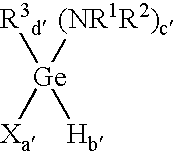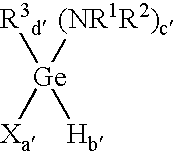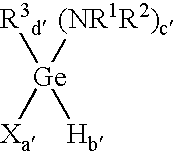Method of depositing germanium-containing films
a germanium-containing film and depositing method technology, applied in the field of germanium compounds, can solve the problems of large safety procedures and equipment, difficult handling of germane-based processes, and high cost of germane-based processes, and achieve the effect of minimizing reactor maintenan
- Summary
- Abstract
- Description
- Claims
- Application Information
AI Technical Summary
Benefits of technology
Problems solved by technology
Method used
Image
Examples
example 1
[0062]Dimethylamino germanium trichloride is expected to be synthesized according to the equation:
LiNMe2+GeCl4→(NMe2)GeCl3+LiCl
[0063]To a stirred solution of germanium tetrachloride (50 g, 0.233 moles) in pentane (100 mL) maintained at 0° C., is added dropwise a solution of lithium dimethylamide in diethyl ether (11.898 g, 0.233 moles, 50 mL) via pressure equalized addition funnel. The addition lasts for approximately 30 minutes. When the addition is completed, the resulting mixture is allowed to slowly warm to room temperature after which a suspension is expected to be obtained.
[0064]When the suspension settles, the supernatant mother liquor is separated using a siphon technique. The precipitate of lithium chloride byproduct is washed with fresh pentane and the washings are separated via siphon under nitrogen atmosphere, and are subsequently combined with the mother liquor. The pentane / ether solvents are then removed via atmospheric pressure distillation by heating the reaction mas...
example 2
[0065]To a conventional vapor delivery device are added (dimethylamino) germanium trichloride and germanium tetrachloride in an expected molar ratio of 45:55.
example 3
[0066]The procedure of Example 2 is repeated except that the germanium compounds in the table are expected to be used in the molar ratios shown. The molar ratios reported are the expected moles of halogermanium compound: second germanium compound.
[0067]
HalogermaniumSecond GermaniumMolarSampleCompoundCompoundRatioAGeCl4Me4Ge95:5 BGeCl4t-Bu(Me)GeH270:30CGeCl4i-PrGeMe325:75DGeBr4Me4Ge80:20EGeBr4(H2C═CH)GeMe340:60FGeBr4t-BuGeH3 5:95GGeI4Et2GeCl270:30HGeI4(NMe2)GeCl345:55IGeI4(NMe2)GeCl320:80JMe3GeClt-Bu(Me)GeH295:5 KMe3GeClt-Bu(Me)GeH222:78LMe3GeCli-PrGe Me365:35MMeGeCl3Et4Ge90:10NMeGeCl3(H2C═CH)GeMe335:65OMeGeCl3i-PrGeMe310:90Pt-BuGeCl3(NMe2)GeCl350:50Qt-BuGeCl3Me(NMe2)GeCl238:62Rt-BuGeCl3t-BuGeH325:75SH2GeCl2Me2(i-Pr)GeH57:43TGeCl4GeBr422:78UGeBr4HGeCl342:58VEt2GeBr2t-Bu(NMe2)GeCl230:70WMe2GeHCli-Pr(Me)GeH247:53XMeGeHCl2Me(Et)GeH221:79YMeGeF3Me2GeEt234:66ZMe2GeF2Et2(Me)GeH15:85AAi-BuGeCl3i-BuGeH350:50BBn-PrGeCl3n-PrGeH342:58
[0068]In the above table, the following abbreviations are use...
PUM
| Property | Measurement | Unit |
|---|---|---|
| Molar ratio | aaaaa | aaaaa |
Abstract
Description
Claims
Application Information
 Login to View More
Login to View More - R&D
- Intellectual Property
- Life Sciences
- Materials
- Tech Scout
- Unparalleled Data Quality
- Higher Quality Content
- 60% Fewer Hallucinations
Browse by: Latest US Patents, China's latest patents, Technical Efficacy Thesaurus, Application Domain, Technology Topic, Popular Technical Reports.
© 2025 PatSnap. All rights reserved.Legal|Privacy policy|Modern Slavery Act Transparency Statement|Sitemap|About US| Contact US: help@patsnap.com



